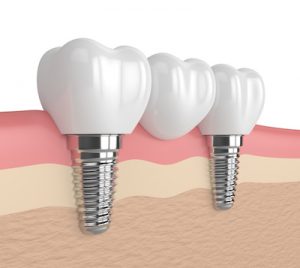If you have a missing tooth or missing teeth, a dental bridge might be a good tooth replacement option. While many people think that dentures are the go-to solution for tooth loss, this couldn’t be farther from the truth. In fact, modern dentistry is coming up with increasingly innovative solutions for tooth replacements, and improving many of the solutions that we’ve already developed—including dental bridges. If you are suffering from loss of functionality, or simply lower self-esteem, because you are missing a tooth or several teeth, you may be the ideal candidate for a dental bridge.
A dental bridge isn’t just a great way to hide an embarrassing hole in your smile or improve your ability to chew or speak clearly. They also have structural benefits—ones that can improve the overall health and safety of the teeth surrounding the bridge.

There are several different methods for replacing missing teeth with prosthetics; dental bridges are one such method. While dentures are a removable replacement, dental implants are a permanent replacement, and involves the surgical insertion of a titanium post directly into the jawbone. Dental bridges, however, fall somewhere between these two. As the name suggests, these prosthetics work by creating a “bridge” between the teeth surrounding the area of tooth loss. Instead of fixing a replacement tooth into your jawbone, or creating a removeable prosthetic, a replacement tooth is affixed on a more or less permanent basis to the natural teeth immediately adjacent to the area of tooth loss.
Bridges are often a good option if you are missing several teeth in a row, but still have healthy, strong teeth adjacent to the area.
There are several different types of dental bridges, including:
There are a number of different reasons that a dental bridge might be the right choice for you. Of course, we always recommend that you consult with your dentist at Anchorage Dental Group first and foremost, but here are a few of the reasons our patients have opted for dental bridges:
Getting a dental bridge requires at least two visits. During the first visit, your Anchorage dentist will prepare the adjacent teeth by recontouring them to accept the custom-made crown that will be used. They’ll also take impressions of your teeth to send to the lab so that your bridge looks as natural as possible.
On the second visit, your custom bridge will be adjusted and attached. If necessary, you may return for future adjustments, per your needs or on the advice of your dentist.
You might be wondering the costs of getting a dental bridge. It all depends on your specific circumstances, the condition of the surrounding teeth, as well as your gum line. For this reason we offer free consultations so that we can perform an exam of the area needing a dental bridge and to help you determine if this is the right procedure for you.
If you think a dental bridge is right for you, call Anchorage Dental Group today for a free consultation!